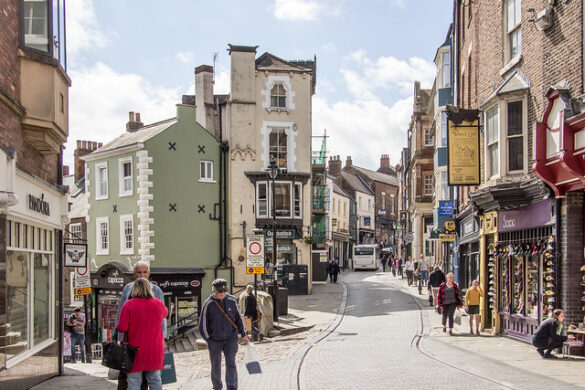Saddler Street is one of Durham’s most iconic and atmospheric streets, a historic thoroughfare that connects the bustling marketplace at the city’s core with the majestic Durham Cathedral and Castle complex. Winding its way uphill through the heart of the city’s medieval centre, Saddler Street is more than just a route—it’s a journey through centuries of architecture, commerce, and local life.
A Street Steeped in History
Saddler Street takes its name from the saddle-makers and leather workers who once plied their trade along this stretch in the Middle Ages. Like many of Durham’s oldest streets, its layout follows the contours of the original Norman settlement that grew up around the Cathedral after the shrine of St Cuthbert was established here in the 11th century. Over the centuries, the street evolved from a residential lane into a vital commercial and social artery.
The street’s gently rising gradient and narrow cobbled form have remained relatively unchanged for hundreds of years, making it one of the most evocative parts of Durham’s historic core. Many of the buildings that line Saddler Street are centuries old, with some dating back to the 17th and 18th centuries, though their facades have often been modified over time to suit changing commercial needs.
Architecture and Atmosphere
Walking along Saddler Street is like stepping into a living museum. On either side of the street are tightly packed buildings with a mix of Georgian, Victorian, and older medieval features—stone-framed windows, steep roofs, timber frames, and hidden courtyards.
Because the street is narrow and curves gently, there’s always something visually interesting ahead—a jutting bay window, an arched passageway, or a glimpse of the cathedral tower peeking out above the rooftops.
Today, Saddler Street is home to an eclectic mix of independent shops, cafés, bookshops, and boutiques, alongside familiar high street names. It’s a popular destination for both tourists and locals, especially students from nearby Durham University. Despite modern touches, many of the businesses respect the street’s historical character by retaining traditional signage and interiors.
The Gateway to Durham’s Treasures
Saddler Street isn’t just a destination in itself—it’s a key route to some of Durham’s most famous landmarks. It leads directly to the Elvet Bridge at one end and to Owengate, the final approach to the Cathedral and Castle, at the other.
This positioning has made it one of the most walked and photographed streets in the city. Pilgrims in the medieval period would have followed this same route on their final approach to the Shrine of St Cuthbert, and the street remains filled with foot traffic from tourists retracing their steps. The transition from the busy shops to the peaceful expanse of Palace Green is dramatic and moving.
Hidden Gems and Side Streets
Branching off Saddler Street are narrow medieval lanes and ginnels (alleys), such as Fowler’s Yard, a creative hub that now houses local artists’ studios and small galleries, and Bakehouse Lane, which winds down to the River Wear. Exploring these offshoots offers a sense of how tightly woven Durham’s old city fabric is, with layers of history hidden just out of plain sight.
Some buildings on Saddler Street also house underground spaces—medieval cellars and stone-vaulted rooms that speak to the city’s long trading and ecclesiastical past. Occasionally, these spaces are used for exhibitions, pop-up shops, or events tied to Durham’s cultural calendar.
Saddler Street in the Modern Day
In recent years, Saddler Street has seen a thoughtful balance between preservation and progress. Conservation efforts ensure that any refurbishment or development is sympathetic to the area’s heritage, maintaining the visual and cultural integrity of this cherished part of the city.
Seasonal festivals such as the Durham Lumiere Festival often feature installations along Saddler Street, using the street’s ancient buildings as backdrops for light shows and artworks. During the university term, the street buzzes with student activity, while weekends draw families, walkers, and visitors heading to the Cathedral or riverside walks.
A Lasting Impression
Saddler Street is often one of the first places visitors encounter when exploring Durham, and it leaves a lasting impression. Its blend of charm, history, and vibrancy perfectly encapsulates what makes Durham special. Whether you’re shopping, heading up to a concert at the Cathedral, grabbing a coffee, or simply enjoying the view, Saddler Street invites you to slow down and appreciate the beauty of a city where the past and present coexist seamlessly.

